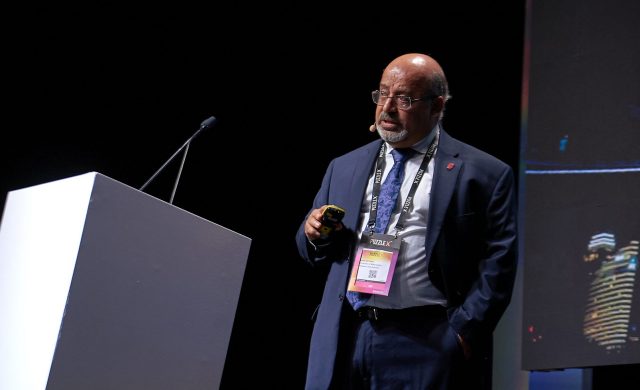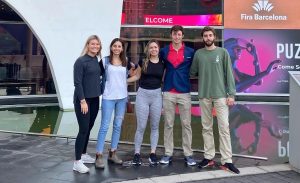
Ahmed Al-Ostaz, UM professor and Brevard Family Chair in Civil Engineering, speaks on graphene and future materials research at the second annual PUZZLE X conference in Barcelona. Submitted photo
OXFORD, Miss. – A team from the University of Mississippi School of Engineering recently joined more than 3,000 researchers, government officials and industry leaders from around the world at the second annual PUZZLE X conference.
Held Nov. 14-17 in Spain, the event focuses on frontier technologies and their potential to create a more sustainable future. Ahmed Al-Ostaz, professor and Brevard Family Chair in Civil Engineering, Sasan Nouranian, associate professor of chemical engineering, and five Ole Miss students traveled to Barcelona for the event.
“The name of the conference comes from the idea that frontier materials are like a puzzle,” Al-Ostaz said. “Everyone has a piece, but until we find that X-factor that completes the puzzle, we all need to continue working together to solve it.”
Al-Ostaz and his team showcased the university’s contributions toward this goal. They highlighted research using graphene, a 2D form of carbon consisting of a singular layer of atoms. The strong and flexible material has a vast range of applications that include strengthening roads and bridges, as well as enhancing electronics and medical treatments.
The university is home to the Center for Graphene Research and Innovation, of which Al-Ostaz is director. Established in 2017, the center serves to advance translational science and engineering of graphene-based technologies.
“We had a very strong presence throughout the conference,” said Al-Ostaz, who gave a talk on graphene and other materials related to infrastructure. “Our intent was to show our leadership in frontier materials. We were happy to represent the U.S., our state and definitely the university.”
Josh Gladden, vice chancellor for research and sponsored programs, also represented the university in a virtual panel discussion about the role of research universities in society.
“Research universities are major players in the development of science,” Gladden said. “We need to consider what we bring to the table and what our responsibilities are. As the only U.S. representative on the panel, it was interesting to see the different approaches that other countries take.

UM mechanical engineering students (from left) Courtney Cruse, Hannah Bradford, Katherine Terry, Nick Greazel and Auston Key attend the PUZZLE X conference in Barcelona, where they networked and heard presentation by leaders in the field of materials science. Submitted photo
“Science and technology are evolving so rapidly that we need to build flexible systems to support this growth. I talked about our success with programs that connect various departments and schools along a particular theme, such as the Center for Manufacturing Excellence.”
Zina Cinker, chief creator of PUZZLE X, said that the university made its mark among the world leaders that attended the event.
“The strong presence of University of Mississippi fortified by Sen. (Roger) Wicker’s remarks on UM’s advances in graphene and materials and the importance of quantum and semiconductors sent a compelling message to the global audience to continue to look to the U.S. and Mississippi research centers for leadership in frontier tech,” Cinker said.
At the conference, the group interacted with industry innovators and directors of top research labs across the globe. However, Al-Ostaz said that the students were the “stars of the show.” They attended sessions and helped organize a reception co-hosted by the university.
“The rate of innovation in the industry of materials is rapidly increasing, and graphene is a major contributing factor,” said Katherine Terry, a senior mechanical engineering major from Bethesda, Maryland. “It’s really exciting to be a part of that by participating in graphene research at Ole Miss.”
Nick Greazel, a junior mechanical engineering major from Arlington Heights, Illinois, appreciated the opportunity to learn from leaders in the field.
“This experience gave me a chance to network with rising stars in science and industry, and learn about new advances in material science,” Greazel said. “Also, being around so many startup companies opened my eyes to all of the kinds of innovation happening outside of traditional corporations.”
Al-Ostaz looks forward to building on relationships formed at the conference.
“We are at the forefront of new materials and new technology at the University of Mississippi,” he said. “We were approached by so many people asking for visits, and to explore the possibilities of partnerships and collaboration.
“That is a testament to the quality of work that we are doing here. It’s the same quality that people in Cambridge and Manchester are doing. We are working parallel – conducting the same research activities and sometimes we are even one step ahead.”